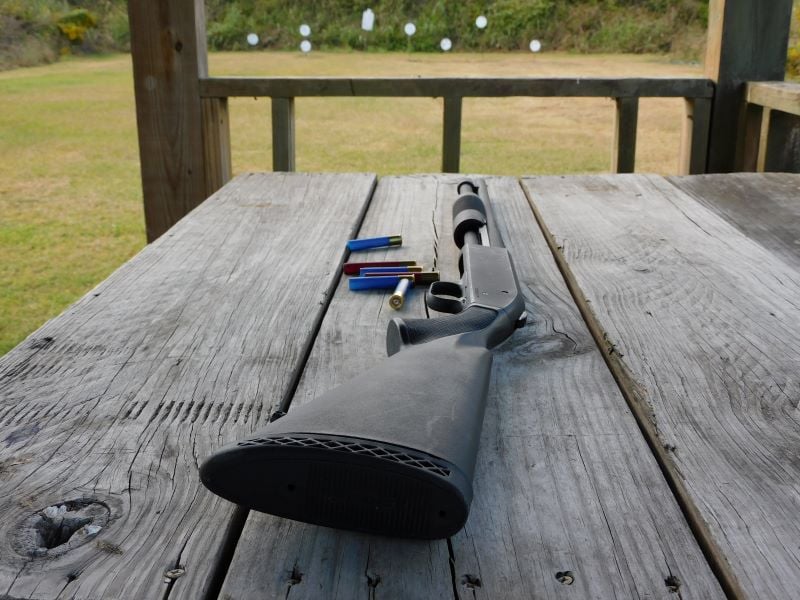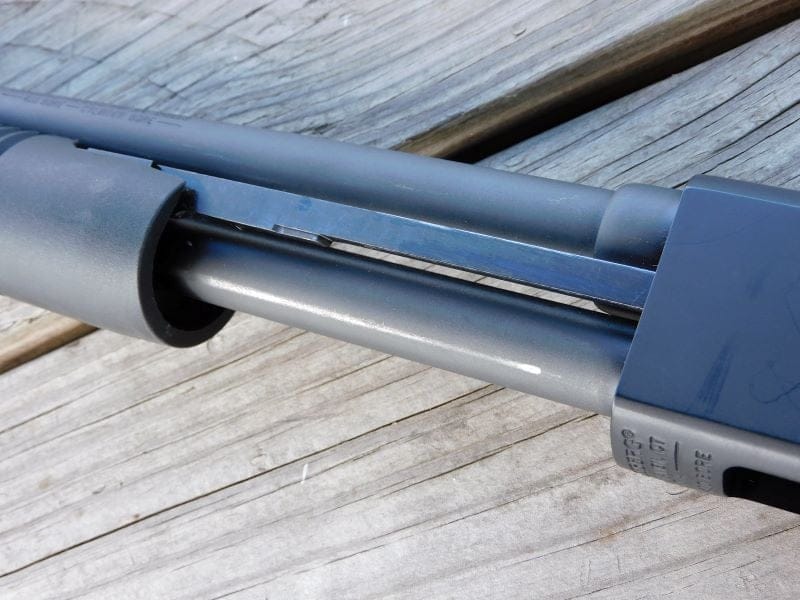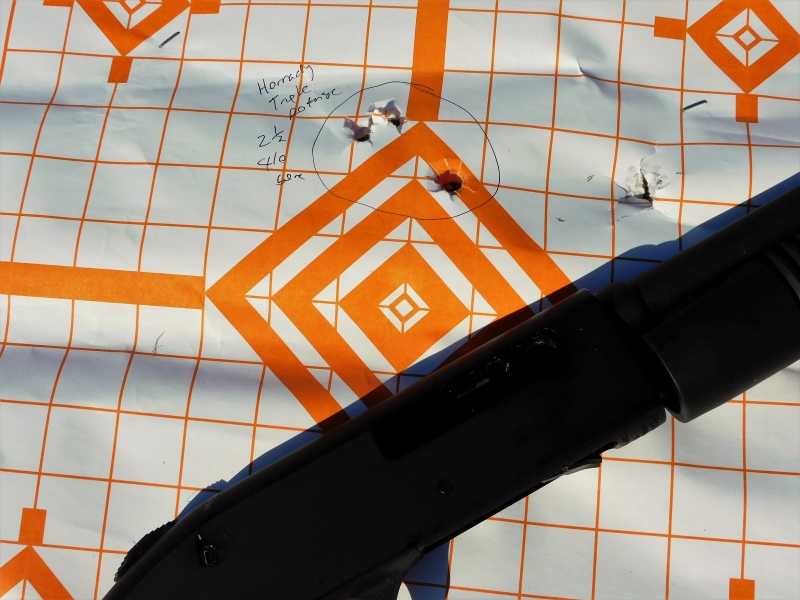The popularity of the 410 bore has waxed and waned over the years but lately the round has been on the upswing. Most major shotgun manufacturers in and out of the States are likely to catalogue at least one variant. The popularity of the Taurus Judge and S&W Governor 45 Colt/ 410 revolvers brought the 410 into the handgunning game and served as the catalyst for a growing number of 410 loads designed for self-defense. Despite these innovations, there are still very few 410 shotguns out there that are set up for personal protection. The Mossberg 590 series is a notable exception.

Features and Impressions
The Mossberg 590 in 12-gauge has been a staple for the US military and law enforcement since its debut in the 1980s. At first glance, the 590 Persuader 410 shares the same features one would expect on a standard tactical model of later vintage: a polymer buttstock and ribbed fore-end, an ambitious tang-mounted thumb safety, a well-rounded matte black anodized aluminum receiver, and a full-length magazine tube that extends to the length of the barrel. But once you squint and then take the gun in hand, it looks like the 12 gauge has been on a quack doctor’s diet.

In hand, the Persuader 410 is lighter. Even when fully loaded with six rounds in its tube magazine, the gun weighs only 5.5 pounds. Likewise, the shotgun is proportionally shrunk. It still retains a standard tapered 18.5-inch barrel, but the girth you would expect to contain a 12-gauge load simply is not there. Likewise, the magazine tube is skinny, fit to the correspondingly skinny 410 bore ammunition. The receiver and fore-end are likewise trimmed down.

The Persuader has the feel and trim appearance of a youth shotgun, but it is built for more serious use. The buttstock has a length of pull of 13 3/4 inches from the rubber butt pad to the trigger—a comfortable shouldering reach for full-sized adults. The full-length magazine tube holds six rounds of either 2.5-inch or 3-inch 410 ammo and the 18.5-inch barrel is cylinder bore with no choke. Most 410 shotties I have run across hold two-three rounds and come with a full choke to get the most out of the round’s small shot patterns. The Persuader 410 is set up for personal protection where more rounds don’t hurt and long-distance patterns are unimportant.
On the face of it, this model’s light weight paired with light-recoiling 410 loads would make a good set-up for recoil-sensitive shooters and for those situations where touching off a 12-gauge might be a net liability. On the other hand, the 12 gauge is far more popular and I had to wonder how well this little 410 model would acquit itself on the range.
Pre-Use Prep
Out of the box, the Persuader 410’s action was sticky to work. When I sought to do a function check with ammunition, the rounds moved sluggishly out of the tube and into the chamber with rounds sometimes getting stuck half-in the chamber. Tugging on the pump sometimes did little. Mossberg tends to bathe their shotgun receivers in packing oil at the factory and this was no exception, but the 410’s action was needlessly stiff. I was relieved to find that a quick disassembly and cleaning restored functionality.
Patterning
After getting reacquainted with the ins and outs of the 590, I started off my range time slowly to understand how this little shotgun patterns. Your standard 12-gauge 2 3/4-inch target load can typically be found with a load of 1 ounce of shot or more. Three-inch 410 shot loads run anywhere from 1/2 ounce to 13/16 ounce. No matter how you slice it, the 410 is working with less shot.
I shot several loads from a distance of 10 yards, starting with Privi Partizan’s 410 2.5 inch No. 7 1/2 lead birdshot. The spread covered the entire target. By contrast, the larger the shot, the tighter the pattern.
Federal’s 3-inch No. 4 buckshot load slung all nine pellets into a 10-inch pattern at that same distance. Hornady’s 2.5-inch Triple Defense load (one .41 caliber slug and two .35 caliber round balls) patterned into a two-inch cluster. The same was true using Federal 410 Handgun 2.5 inch 000 buckshot. This particular shotgun grouped those loads about five inches above my aiming point. The recoil with all of these loads, even in this little shotgun, was negligible.

Picking Up the Pace
After figuring out where this particular shotgun hit, I decided to load up and do some rapid-fire drills. Loading the 590 with stubby 2.5-inch bird loads was easy. You can drop them in the loading port and thumb them forward into the tube with ease. I was able to do so with my eyes on a set of clay pigeons I set up down range at 20 yards.
After the tube is loaded, you have to rack the pump back and forward again to open the action, cock the hammer, and bring a round into the chamber in order to fire. If the hammer is already cocked, you have to remember to depress the bolt release behind the trigger guard that will allow the pump to retract.
With that, all you have to do is thumb the safety forward, press the trigger, and then cycle the pump to feed a new round. Then, repeat the process. In theory, this can be done very quickly but the sluggishness I had cleared up before heading to the range returned. With deliberate rearward motions, I could easily eject spent cases but once the elevator began to feed a new round into the chamber, the pump would bind as I pushed it forward. The front of the round reaches the rear wall of the chamber and stops without chambering at all. It takes some jiggling with the pump before it can go home and seat a round.
Thinking it may have been an ammunition problem, I switched to Federal and Winchester 2.5-inch No. 6 lead shot loads and had the same problem. Worse, briskly working the action to ensure proper function meant that I occasionally had a live round completely fly off the elevator and onto the ground and the pump closes on nothing. I dusted my clays without a problem, but I could not get through a string of six rounds without a bobble.

After this session, I disassembled the shotgun once again. After hosing it down with brake cleaner and giving it a thorough cleaning and lubrication job, I checked for obvious wear patterns and saw nothing. I also paid attention to the parts in motion while working the action, with particular emphasis on the interrupter. But all parts moved as they should.
I revisited the Mossberg 410 once again and tried a mix of 2.5- and 3-inch shells. Using the shorter 2.5-inch shells, the binding continued. During this run, I began to notice how much flex there was in the action, with plenty of excessive lateral movement of the action bars and the fore-end. What was not in play at the shop was so in the field.
As a last trick, I tried longer 3-inch Magnum shells. In particular, a few boxes of Federal No. 4 Buckshot and Winchester Super X No. 4 birdshot. These longer shells are more difficult to load into the port and have to be started into the tube before they can be laid into the port to be fully seated. I could only get four of these longer shells into the tube.
Even with fewer shells to mess with and less distance between the front of each round to the chamber, this Mossberg 590 continued to choke; the only remediation that worked is slowly and forcefully working the action. After 200 rounds down the pipe, I gave up.
Parting Shots
On paper, the Mossberg 590 Persuader 410 is perfect in the niche of low-recoiling personal protection options. Light, trim, and mechanically simple, the Persuader is easy to handle and the few controls are easy to understand with the safety, pump, and bolt release in easy reach. Further, its six-round capacity, though bog standard for 12-gauge tactical shotguns, is high as far as 410 shotguns are concerned. But when you get beyond the purchase and start shooting and looking for suitable modifications, this model falls somewhat short.
Sometimes when a given design is scaled down, a previously bullet-proof design becomes problematic. Out of all the 1911 pistols I have seen on a firing line, I have seen far more issues with pug-nose 3-inch and 4-inch Commander models compared to the standard, boring Government model with a five-inch barrel. The same might be said when taking the Mossberg 590 12 gauge and shrinking it down for 410. I have handled quite a few Mossberg 410 models and I can say with some confidence that the actions are far too dainty and never run as smoothly as a comparable 12 gauge. While I am confident that continued shooting with some patience, or a trip back to Mossberg, might remedy these issues, it is not exactly the answer for the everyday home defender.

